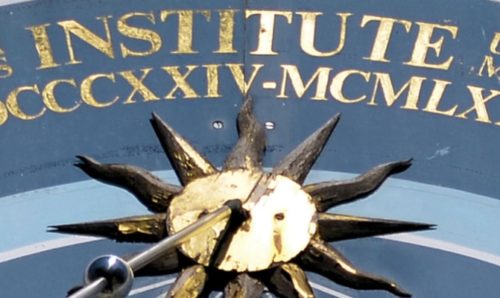The science of storytelling
UOM life 25th May 2017
Ever wondered why Schrödinger’s cat became so famous – or who Schrödinger is, for that matter? And could an infinite number of monkeys really type the complete works of Shakespeare? And if they could, how does this help scientists anyway?
Well, it turns out that cats stuck in boxes, monkeys with aspirations to write and demons with time on their hands can all help scientists immeasurably. Each of these creatures is at the centre of its own thought experiment. This is a tool used by scientists to consider a theory from all angles – to prove or disprove it and to understand its consequences.
Cat in the box
Let’s take Schrödinger’s cat – perhaps the most famous thought experiment of all time. Physicist Erwin Schrödinger put forward the hypothetical case of a live cat being placed inside a windowless steel box. Also in the box is a Geiger counter and a microscopic piece of radioactive material. Should one of the radioactive atoms decay, the Geiger counter will set off a mechanism that results in a small amount of hydrocyanic acid being spilled – killing the cat. If the atom doesn’t decay, nothing will happen and the cat will be fine (albeit lonely, hungry and trapped in a box).
Because over the next hour there is an equal chance that one of the atoms will decay or won’t decay, there is also an equal chance of the cat being alive or dead. As there is no way of seeing into the box to check, this means that – according to the theory of quantum mechanics – the cat is both alive AND dead.
Confused? We’re not surprised! But what you might not know is that Schrödinger actually came up with this paradox to highlight the problems he saw with the Copenhagen interpretation of quantum mechanics – not to prove it, as is the popular assumption. Quantum mechanics deals with science on a microscopic level and Schrödinger wanted to show that when the science was applied to something larger, it became ridiculous. He did so with his dead-alive cat.
“To be or not to be (in a roomful of monkeys)”
Which brings us to a room of immortal monkeys – or rather, one immortal monkey. While the theorem often conjures up the image of a roomful of monkeys, it is actually just one monkey typing forever that’s at the centre of this thought experiment. Given enough time to smash the typewriter at random, the monkey will “almost surely” bash out the Bard’s back catalogue. But, if the room – and the entire observable universe – was full of monkeys typing away for billions and billions of years, this probability actually falls.
So, what’s the point of this theory? Well, it’s simply the proposition that, given enough time, order can come from chaos and anything can be created by random input.
Both the ‘the infinite monkey typing pool’ and ‘Schrödinger’s cat’ have been used as the inspiration for a couple of the short stories that feature in Thought X, the latest in Comma Press’ series of short story collections inspired by real science. Other titles in the collection include When It Changed, Litmus and Lemistry.
The book is a unique blend of science and fiction. As a starting point, the authors received a thought experiment to inspire their short story, and the scientists were then asked to write an afterword that turned the fiction into facts.
Call the scientists
UoM Faculty of Science and Engineering’s Dr Rob Appleby and Professor Sarah Bridle were among the scientists invited to add scientific weight to stories by the likes of Ian Watson (who wrote the screen story for Steven Spielberg’s A.I. Artificial Intelligence) and Robin Ince, presenter of BBC Radio 4’s The Infinite Monkey Cage.
As a starting point, the authors received a thought experiment to inspire their short story, and the scientists were then asked to write an afterword that turned the fiction into facts. Dr Appleby, from the School of Physics and Astronomy at the University, assisted writer Ian Watson on his story inspired by ‘the infinite monkey typing pool’. Professor of Astrophysics Sarah Bridle, meanwhile, worked with Adam Roberts on a story about Olber’s Paradox – which was well suited to the Jodrell Bank astrophysicist. The experiment argues against the belief that the universe is infinite, eternal and static by pointing to the darkness of the night sky.
Thought X was born a few years ago when Comma Press commissioned five short stories inspired by scientific thought experiments. Dr Appleby was asked to act as a consultant for authors Sarah Schofield and Marie Louise Cookson on their stories, which explore ‘Laplace’s demon’ and ‘Maxwell demon’ respectively.
Devil’s in the detail
Speaking at the time, Dr Appleby said: “There’re so many [thought experiments] to do and they’re so interesting. But then there’s a couple that don’t get as much press as the others – and they both have devils in them!”
‘Laplace’s demon’ imagines there’s a demon who knows the position of every particle in the universe and the speed it travels. Using classical physics such as Newton’s Laws of Motion, the demon is able to take this information and calculate the position and speeds of each particle in the next instant in time, the one after that and so on. Armed with this information, the demon can also work out the position and speed of every particle at every point in the past. This means that for the demon, tomorrow is predetermined – so what happens to free will?
‘Maxwell’s demon’, meanwhile, throws a trident in the works of the theory of thermodynamics, which states heat always flows from hot to cold. “The devils are there to play an interesting role. They’re there to be a little mischievous,” Dr Appleby explained. “The demon is trying to teach us through a thought experiment [to ask] is the theory true and what are the limitations of the theory.
“[The demons] stretch us to ask ‘how good is your physics? Is there a way to circumvent what you grandly call a fundamental principle?’ And also they’re really good devices to produce good works of short fiction.”
Thought X is out now.
Words – Hayley Cox




